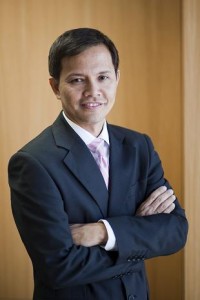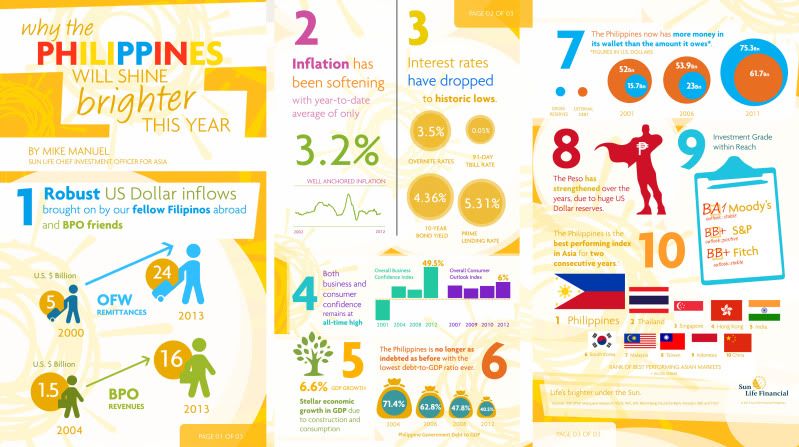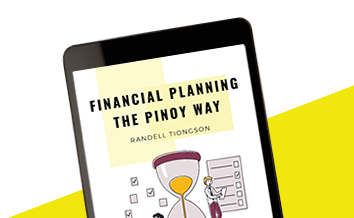2014 Outlook, part 2
By Randell Tiongson on January 8th, 2014
To start the 2014 outlook series, it is both an honor and a privilege to be featuring the views of the Chief Investment Officer of the country’s largest bank, BDO – Marvin V. Fausto. Marvin is one of the most respected and most admired fund managers of the country and he also steers perhaps the largest investment funds in the Philippines. A marathon runner, husband to Rose Fausto (also a finance advocate) and father of the now famous Fausto Boys, the often featured young investors.
The 2014 Outlook of Marvin V. Fausto
2014 will be mixed given the developments we have seen in 2013. While the macro fundamentals of the economy continue to perform above historic trends, our financial markets have priced in much of the gains and may just undergo a period of consolidation with a downward bias this year. Interest rates are expected to pick up and thus may affect bond prices while the stock market continues to trade at a premium versus other markets and thus may just trade within a narrow range for most part of the year. These expectations, however, can change should external markets react differently given the winding down of the quantitative easing from the US.
More importantly however, the macro positives have yet to be felt in a more meaningful way by majority of the Filipino population. Poverty figures remain elevated having more than one fourth of our population considered poor with unemployment relatively high. Even with the employed and those with sufficient source of living, they continue to grind just to live by and survive, as they have done in the past. The challenge then is to break that vicious cycle and uplift the general public to a higher level in achieving the prosperity that all Filipinos deserve. After all, the only way the country can be prosperous is for each and every Filipino to be prosperous. With the low interest rates expected to be prevalent for some time, my view is for more and more Filipinos becoming aware of the investment instruments available to them and eventually participate in a more meaningful way to lift their financial well being over the long term.
So as we move to the new year in 2014, there is much hope that things will improve for the better. The economic growth is projected to remain at above trend of 6-7% with inflation be within controllable levels. Government has generated sufficient funds to stimulate growth through infrastructure spending and government consumption that are expected to pump prime economic activity. This is coming at a time when theorists believe will happen at a most ideal time to prepare the country to stimulate improving demographics where majority of the Filipinos will reach their most productive age when more than 65% will reach ages from 15 to 65 years old that is projected to start in 2015 and will run in the next 20 to 30 years.. These were levels when other countries as well reached their most productive growth cycle in their economic history such as Japan, Malaysia, China, and Indonesia.
This year should therefore be the time to seriously plan for the future by investing in ourselves and in financial instruments that will greatly benefit them in the future. Even with challenging market views, opportunities abound and will reward those disciplined enough to participate.
 Marvin V. Fausto is the Senior Vice President and Chief Investment Officer of the country’s largest bank, BDO Universal Bank and in charge of the Investments unit managing over P600 Billion under the BDO Trust Banking Group.
Marvin V. Fausto is the Senior Vice President and Chief Investment Officer of the country’s largest bank, BDO Universal Bank and in charge of the Investments unit managing over P600 Billion under the BDO Trust Banking Group.
Prior to this, he held the position as head of the Trust Banking Group of Equitable PCI Bank from 2002 to 2007 primarily responsible for its overall business and operations. He also held the position of Vice President and Investments Head at Citytrust Banking Corporation. He started his career as an analyst at the former Far East Bank & Trust Co.
After having served as President and director, Mr. Fausto is currently a Board Adviser to the Trust Officers Association of the Philippines, the umbrella organization of the Trust Industry. He was also the Founding President and current Director of the Fund Managers Association of the Philippines.
When the markets did the jerk
By Randell Tiongson on July 3rd, 2013
Sometime ago, I posted an article written by Antonio Moncupa Jr., the CEO of East West. Here’s another insightful from the CEO of one of the fastest rising banks of the country. He wrote about the way the markets behaved.
——————–
The Dance of the Markets
By Antonio Moncupa Jr.
In June, the markets did the jerk. They danced up and down and roiled throughout the  month. From its peak on May 15 to end June, stocks are about 13% lower, after falling more than 20% at its lows. The long bonds, on the other hand, are down around 12% in value after losing around 20% at its lows. And the peso hit a low of P44.17 against the dollar.
month. From its peak on May 15 to end June, stocks are about 13% lower, after falling more than 20% at its lows. The long bonds, on the other hand, are down around 12% in value after losing around 20% at its lows. And the peso hit a low of P44.17 against the dollar.
Unfortunately, to make our moneywork well for us, we have to work to learn about investing or pay those we trust whose business is to invest for others. Or, we could always take the low yield but safe alternative of short-term deposits from banks we know about, even if it practically does not pay us anything. A little yield is much better than possibly losing part of our principal as some stock and bond investors recently found out. We thought that it would help to have some sense of what is happening. How could it be that all it took were some words from Chair Ben Bernanke of the US Federal Reserve, that they would stop printing money (they don’t really print, they just press some keys in their computer keyboard) and voila, we saw a fast and furious sell-off of stocks and bonds and local currencies indiscriminately across the developing world, including the Philippines.
The US is so far and yet so near
When the US real estate and credit bubble burst, it threatened to bring down the US economy and the world with it. Real estate prices dropped and banks’ bad loans piled up. When real estate prices go down and banks are saddled with bad loans, people feel poorer and would not want to spend. Banks lose their lending appetite. If this is allowed to persist, people will stop buying things and economic activity slows down. There will be less need for workers and unemployment soars. This will further cause demand for things to drop even more and before you know it, the country’s output starts to go down bigtime. To avert a full-blown crisis, the US Fed launched an intervention called quantitative easing or QE. Another term for QE is money printing. This is done with the US Fed buying bonds and other financial instruments and paying for it by creating new money. When there is demand for anything, prices go up. In the world of bonds, interest yields move in the opposite direction and interest yields went down. With the Fed driving US interest rates near zero, investors looked elsewhere where yields and potential returns are better. That elsewhere turned out to be the developing countries like the Philippines. Foreign investors came, sold theirdollars for local currencies and started buying stocks and bonds. With too much dollars coming in, currencies appreciated. And before you know it, interest rates fell and stock markets soared.
Meanwhile, back in the US, low interest rates encouraged re-financing of people’s debts to get lower interest rate. This freed up some cash for spending. Companies and consumers found it wonderful to borrow at low rates. And with money in their hands, they started to spend and be more confident of the future. In due time, housing prices started increasing and spending perked up. The economy started to show some recovery. But too much money and too much demand for things will push prices higher and create inflation. The Fed is tasked to prevent that and, at some point, will act to get back the money it released. There will be three phases. In Phase 1, it will slow down creating new money like from $85 billion a month, down to maybe $60 billion. This is called “tapering.” As Americans become more optimistic and the recovery gains traction, the Fed goes to Phase 2, where it will stop creating money altogether. And finally, before banks seduce companies and consumers to borrow excessively and spend excitedly, Phase 3 comes in where the Fed gets back the money it created by selling the assets it bought. Just as US interest rates went down when the Fed began creating money, interest rates will go up when money is retired anew. Just the thought of it pushed US 10-year yields from 1.6% to 2.5%.
Some Opportunities?
With US yields and its stock market expected to go higher as the find US assets more alluring. That was the stampede we saw in June. Stampede back to the US. In the meantime, just as investors got carried away when they came and pushed stocks too high, peso too strong and interest rates too low, the rush to the exit probably pushed stock market too low, the peso too weak against the dollar and interest rates too high. Or, it may have not. This is now the subject of a lively exchange of opinion and the debate is causing local markets to do the jerk. And this debate could mean a lot to us who are investing our savings. The debate is not yet settled. But we don’t make good money when it is finally settled. By that time, it’s either you already missed the buying opportunity or will be buying at very expensive levels. Already, the stock market is gaining and interest rates are falling from its highs. Is this temporary? No one really knows for sure. But some things will surely happen although we don’t know when. The US will recover and interest rates will normalize higher from present levels. Though there will be volatility, fundamentals will eventually assert themselves. Remember that the Philippines has a good level of foreign currency reserves, earns more than it spends (before debt payments), has strong banks, and has consumers and companies that are not overburdened by debts. These should be good for stocks but not necessarily so for too low interest rates. When there is overexcitement around, the thing to do is to stay calm and study things carefully. If you run with the herd, you might get trampled upon. If you don’t, you might be left behind. Unfortunately, this is easy to say but hard to do.
*****
Tony Moncupa, Jr. is the President and CEO of East West Banking Corp. Please e-mail your questions, comments, suggestions to easttowest.inquirer@gmail.com.
Originally published in Inquirer
10 Reasons why 2013 will be a great year
By Randell Tiongson on February 7th, 2013
2013 is turning out to be a great year for the Philippines. Mike Manuel, Chief Investment Officer of Sun Life Asia listed down 10 reasons why he thinks “The Philippines Will Shine Brighter This Year”.
- Robust U.S. Dollar inflows
- Inflation has been softening
- Interest rates have dropped to historic lows
- Both business and consumer confidence remains at all-time high
- Stellar economic growth
- Philippines no longer as indebted as before (Debt to GDP ratio)
- The Philippines now has more money than the amount it owes
- The Peso has strengthened over the years
- Investment grade within reach
- The Philippines is the best performing index for two consecutive years
Below is a nice ‘infographic’ with details from Sun Life.

 Marvin V. Fausto is the Senior Vice President and Chief Investment Officer of the country’s largest bank, BDO Universal Bank and in charge of the Investments unit managing over P600 Billion under the BDO Trust Banking Group.
Marvin V. Fausto is the Senior Vice President and Chief Investment Officer of the country’s largest bank, BDO Universal Bank and in charge of the Investments unit managing over P600 Billion under the BDO Trust Banking Group.


